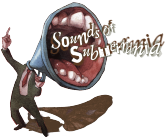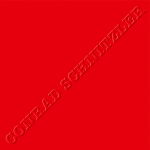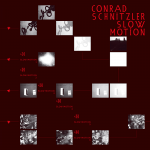Artists
Hier findet ihr die Künstler/Bands.
CONRAD SCHNITZLER
- 01. Meditation
02. KrautrockCONRAD SCHNITZLER
Rot
[engl] There was a particular type of artist who could only have emerged in the legendary early 1970s. Few musicians fit the bill better than Konrad Schnitzler. Revolution, pop art and Fluxus created a climate which engendered unbridled artistic and social development. Radical utopias, excessive experimentation with drugs, ruthless (in a positive way) transgression of aesthetic frontiers were charac- teristic of the period. The magic words were “subculture”, “progres- sivity” and “avant- gardism”. West Berlin, with its unique political status, was a crucible of turbulence. Founded in 1968, Zodiak was the ultimate point of convergence for subculture in West Berlin, with Konrad Schnitzler the driving force behind it. It was also here that Tangerine Dream and Kluster first met up to perform in public. The red album (“Rot”) was Schnitzler’s first solo effort. As a member of Tangerine Dream, however, he had participated in the band’s debut release “Electronic Meditation” some three years earlier (1970). He, Dieter Moebius and Hans-Joachim Roedelius had also already founded Kluster, whose first album “Klopfzeichen” attracted a wealth of attention. On “Rot”, meanwhile, Schnitzler uncompro- misingly pursued his very own vision of electronic music. As an acolyte of action and object artist Joseph Beuys, Schnitzler embraced the former’s “extended definition of art”, in which controlled randomness assumed an important role. Schnitzler actually extended the concept of “music”. Or to put it another way: he cared not one iota for existing rules of music, preferring to create his own or conceptualizing a certain degree of lawlessness. Improvisation grew in importance. The most exciting aspect of Schnitzler’s music is not the fact that he only used synthetic sound and noise; the apparently chaotic movements of his microscopic particles of sound draw the listener into a paradoxical, yet also crystalline and vibrant artistic world. It doesn’t get much more outlandish than this. Schnitzler’s debut surpassed virtually every other pioneering artist of the day in terms of radicalness. Not content merely with making psychedelic soundtracks, he turned these on their head with his defiant artistic will. The rigour of his approach has never been matched. Schnitzler’s inimitable cascades of sound and their transparency were, and remain, unique.- Format
- LP
- Release-Datum
- 22.09.2023
- EAN
- EAN 4015698269789
- 01. Slow Motion 1
02. Slow Motion 2
03. Slow Motion 3
04. Slow Motion 4
05. Slow Motion 5
06. Slow Motion 6
07. Slow Motion 7
08. Slow Motion 8
09. Slow Motion 9
10. Slow Motion 10
11. Slow Motion 11
12. Slow Motion 12
13. Slow Motion 13
14. Slow Motion 14CONRAD SCHNITZLER
Slow Motion
[engl] All manner of trailblazers shaped the soundscape of the era. Conrad Schnitzler (born 1937) and Karl Horst Hödicke (born 1938) – longstanding members of the official artistic canon – were multifunctional artists who painted, performed, sculptured, made films and music. They were always to be found on the edge of the “permissible” and invariably went beyond “modern” perceptions of art. Schnitzler, Hödicke and many of their contemporaries arrived at a completely new definition of the avant-garde. The circumstances of Schnitzler and Hödicke’s first meeting are unknown, but it should come as no surprise that it was Schnitzler who composed the soundtrack for Hödicke’s film entitled “Slow Motion” in 1976. The two artists were cut from the same cloth, routinely crossing any boundaries they happened to encounter. Schnitzler wrote music for each of the film’s 14 sequences, linking them together in a logical progression of minimalist imagery. Each piece of music quite brilliantly accentuated the preceding one. Schnitzler’s musical sensibility was wholly compatible with Hödicke’s approach to film. Not that Schnitzler was ever a film composer. “Slow Motion” worked because Schnitzler and Hödicke were on the same wavelength, daring to experiment with sound and vision in such a way that auditory and visual components were interdependent. Nevertheless, it still makes sense to release the soundtrack without the images. Schnitzler undoubtedly responded to the pictures as he composed, but his customarily uncompromising style is very much in evidence: rhythmically structured electronic cascades, intermittent impulse chains and manual improvisations alternate with planar clouds of sound. Analogue sequencers and an analogue rhythm machine played a crucial role. The tracks on “Slow Motion” vary in length (the shortest is only 58 seconds long) and mood, but the listener never has to leave Schnitzler’s sonic universe, even without the pictures for which the music was composed. “Slow Motion” is an important document in Schnitzler’s oeuvre, seamlessly taking its place alongside his many other releases, whilst also highlighting his constructive input as an equal partner in an experimental film production. What makes “Slow Motion” particularly worth listening to is the fact that Schnitzler surrenders none of his aesthetic independence at any point in the project. It is an enduring document of its time. Asmus Tietchens, 2024- Format
- LP
- Release-Datum
- 10.05.2024
- EAN
- EAN 4015698843064


